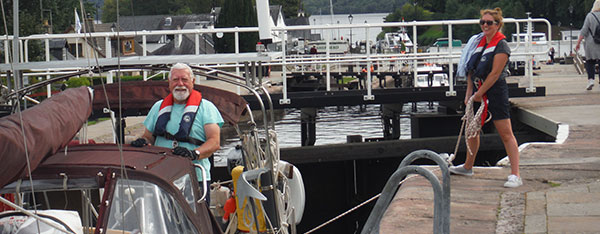Port Edgar (Edinburgh) to Fort William in the Scottish Highlands

Sailing the East Coast of Scotland to the West Coast of Scotland Through the Caledonian Canal.
At last, after six years on the hard (in a cradle on land) at Port Edgar Marina, we finally launched Toucan on August 10, 2022. It was a long slog to service or replace all the electronics, and overhaul the engine, re-glass the dodger, replace the batteries, install a solar controller, varnish the interior, and so on from bow to stern. Sixteen pages of repairs and installations were in our notebook. And then it was time to “Get out of Dodge”
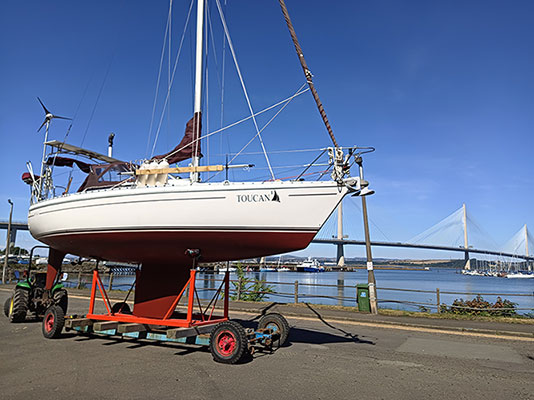
Toucan at Port Edgar in the cradle before launching
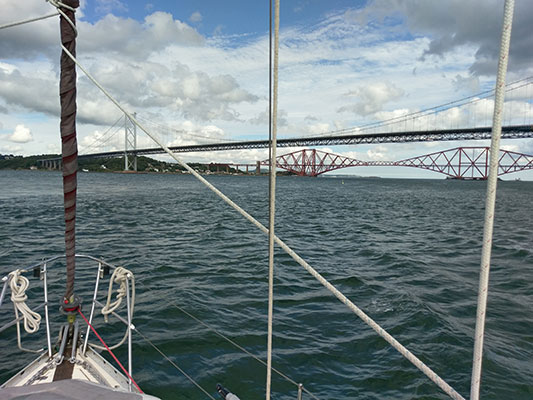
Toucan heading out towards the Firth of Forth Bridges
A few surprises were still waiting for us. After launching, I discovered that the engine did not have reverse gear, and it did not take too long for the engine to overheat, as there was no cooling water coming out of the exhaust. However, once I slowly manoeuvred Toucan into the slip, it gave us time to investigate the issues further. We also noticed that the engine oil warning light would not go out, and the wind generator kept shutting down every couple of seconds. Just when you think you have installed everything correctly, the real world jumps up and bites you on the bum!
This is called “sea trials” and it is a chance to get all the issues resolved before going to sea. The two brand-new UK Aircraft Carrier “Queen Elizabeth” and the “Prince of Wales” had just launched across the Firth of Forth on the other side of the estuary the previous year, and they were almost a year undergoing “sea trials”. The marina had booked us a slip and charged us for the month, which gave us plenty (too much) of time to iron out all the bugs.
I stripped the engine to discover that a 1-inch screw plug had not been replaced when reassembling the engine. It was hidden behind the sea water pump, so not easily seen. That solved the lack of engine oil pressure. And now the oil light went out when starting the engine. When the engine was running, the alternator was not charging the batteries, so I swapped it out for the spare alternator, which worked fine.
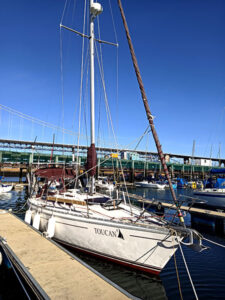
Toucan in the berth going over all the systems – “Sea Trials”
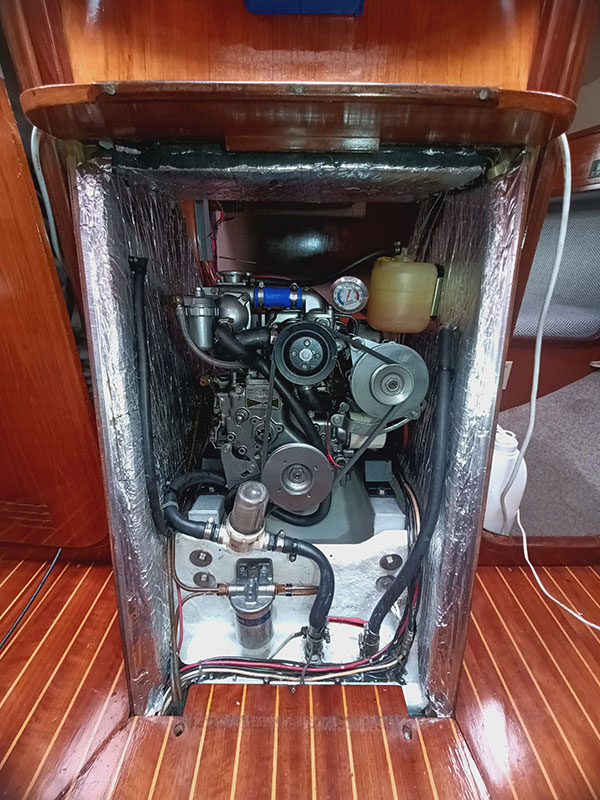
The refurbished engine (special thanks to John Walker) and the reworked engine compartment
I brought down the wind generator and disconnected the third ground wire, thinking that this was the cause as this wire was never connected before. But I had connected it when doing a full service last winter. After remounting it, it proved to be exactly the same as before – it shut down every few seconds in a high wind. Then it dawned on me that the batteries were brand new and fully charged, and the solar panels were also adding to the voltage level of 14.2 volts, so the wind generator sensed the batteries were fully charged and shut itself-down. So, I dismounted the wind generator once again and reconnected the third ground wire. Problem solved. It had never done this all the way across the Atlantic, and when I was servicing it, I found an internal wire that was burned through, so I replaced it and the wind generator was now working properly for the first time. Never seeing it shut itself down before, I thought it was broken – LOL.
The lack of reverse was a simple adjustment of the controller cable to the gearbox to fix it. The seawater was now pumping just fine through the heat exchanger, so taking the engine apart for the oil plug had somehow fixed an airlock in the saltwater pump.
By the 24th of August, the sails were on and the dodger and bimini were up, the fenders and fender boards for the canal trip were tied to the lifelines, the life raft was mounted, extra fuel and water was stowed, and the galley well-provisioned with pre-made stew, pasta bake, Hamburger Helper. I drove the car back to the house and our neighbour, Hugh, drove me back to the boat. The mid-afternoon was for fair winds, so we unplugged the mains, cast off the lines, and set off for our new home in the west coast of Scotland.
We left Port Edgar on the tide (high) so that we would get an extra 1.5 knots going out the firth of Forth. We had a reefed mainsail and half a genoa and were maintaining 6 knots with the tide. Passing under the Firth of Forth road and railway bridges for the last time, and to see them slowly drift astern while we sailed eastwards down the Firth of Forth Past Leith, Edinburgh and Arthur’s Seat off in the distance, and heading towards the North Sea. It was a daunting prospect. We would normally sail out for a half a day and turn and sail back, but not today as we sailed off into the distance with no intention of heading back. We were treated to a really nice sunset at the back of the boat as we sailed on into the night, which cheered us up.
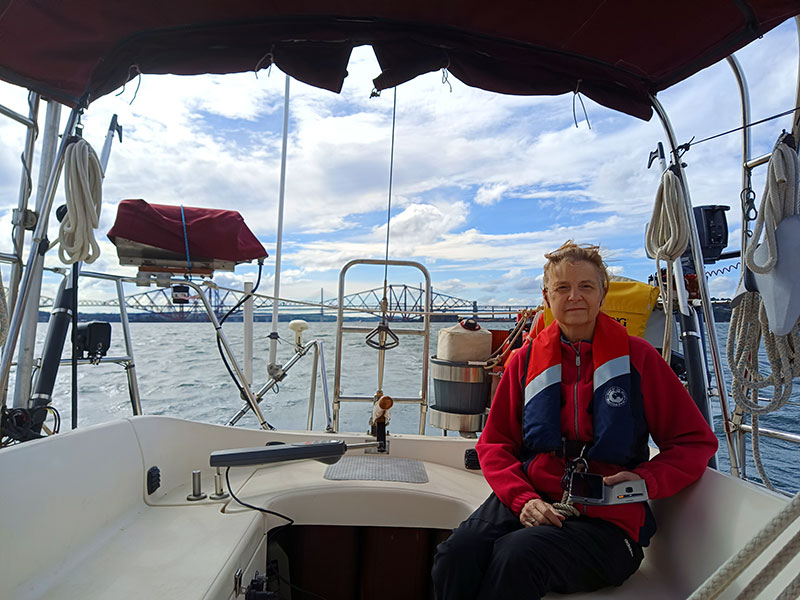
The bridges well behind us for the last time

Sunset on the first night leaving the Firth of Forth Estuary
I thought it would be easier to have just the genoa up which can be adjusted easily from the cockpit instead of the mainsail for the approaching night sail. We headed into the wind to drop the main sail and I could hear the lack of exhaust water coming from the engine. The air lock was back – so no engine until it was solved. No panic as we were intending to sail to Peterhead anyway and it was at least 36 hours away. An engine would be ideal for entering the Peterhead port as it is a busy commercial harbour with all sorts of large vessels entering and leaving at all hours. You have to contact the harbour master in order to get permission to enter or leave.
We decided to keep the Isle of May to our port side and go on the outside of the island as the chart showed that the area on the inside was marked as a fishing area – lobster pots etc… and you do not want pot floats as a hazard during the night. One less thing to look out for. As it turned out it was a fairly quiet night although quite cold in the North Sea for that time of the year, but we were well suited for the cold weather with our offshore Henry Lloyd sailing outfits. There were quite a few large ship lights on the horizon and what seemed like a city of old oil derricks from the oil drilling industry further up in the North Sea, being stored in groups further out to sea, North East of the Isle of May.
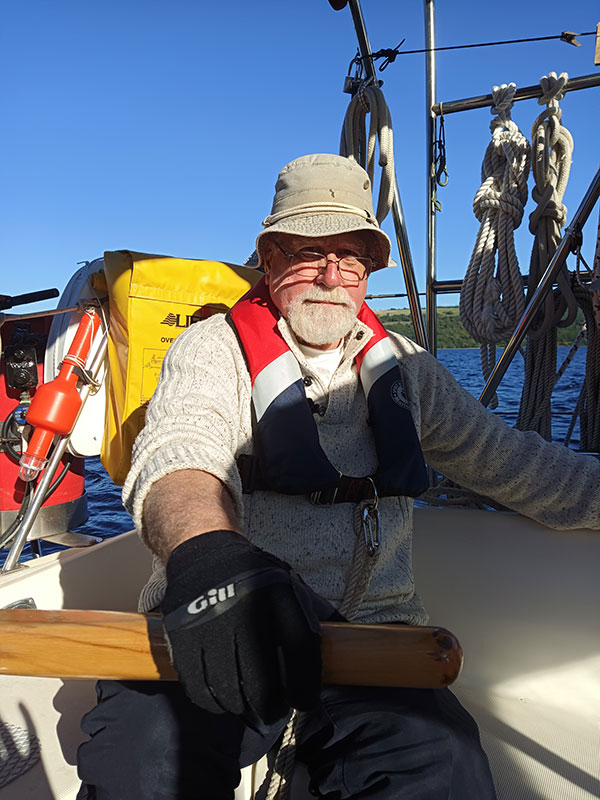
Willie at the helm
The wind died slowly during the night (around 3 am) and we were somewhat adrift, going North at one point with the current and then slowly in reverse when the tide changed. While becalmed we maintained half hourly watches. By the morning the wind had started to pick up and we managed 4 knots to the good 10 nautical miles offshore with a heading of 020 Deg true. We were sailing along quite well passing off Bell Rock Lighthouse (Dundee), while avoiding the lobster / crab pots that would occasionally sneak up. This gave me time to take apart the cooling salt water system from the intake to the sea pump to the heat exchange and on to the exhaust system, everything looked fine and I could not find any source of an air leak or anything wrong. The salt water pump looked fine and the impeller was a new one only a few hours old. Oh well, we may have to sail into Peterhead Harbour, and I was not looking forward to doing that.
The day was fairly uneventful, just avoiding the occasional pot and odd large wind generator group. The day was overcast and the seas were 1 to 3 feet, quite calm for the North Sea. The large Hamburger Helper and Spaghetti Bolognese meals we had cooked up the day before leaving was proving itself to be easy to have a good meal while underway. A large bag of ice in the cool box kept everything nice and cold. It was really nice to be underway and sailing once again after all those years on the hard. The boat was handling quite nicely. And Otto the pilot (Autopilot) was working very well. The solar panels were providing electricity during the day and the wind generator was helping somewhat and no longer constantly shutting down. All this despite the expensive solar panel charge controller failing, we simply bypassed it and had the solar panels charge directly into the batteries.
The second night was another almost windless night and we were adrift once again on calm seas for a little while starting around 3:00 am. Towards the morning the GPS was reporting 1 to 2 knots to the good, so it was worth leaving the sails up. The odd boat was either entering or leaving Aberdeen harbour as we passed a good distance off. There were 5 wind generators in a group out to sea where we were, and about 20 nearer to shore. It picked up a little more so we were making somewhat of a headway, 3 kts, 20 nm from Peterhead. About 7 hours from now about 2:00pm and this would be high tide, perfect. I decided to check the engine cooling system to see if I bled the diesel lines properly the day before, and lo and behold the engine was instantly pumping out seawater from the exhaust once again! So, there was no point in turning off the engine, just let it idle for a few hours while sailing, until we reached Peterhead so we could motor through the harbour entrance.
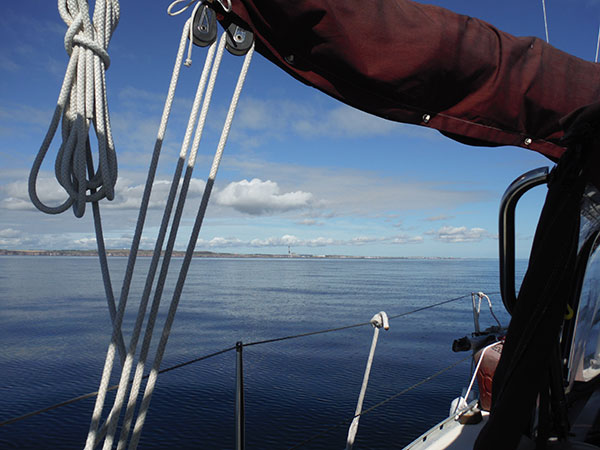
Flat calm seas on the approach to Peterhead
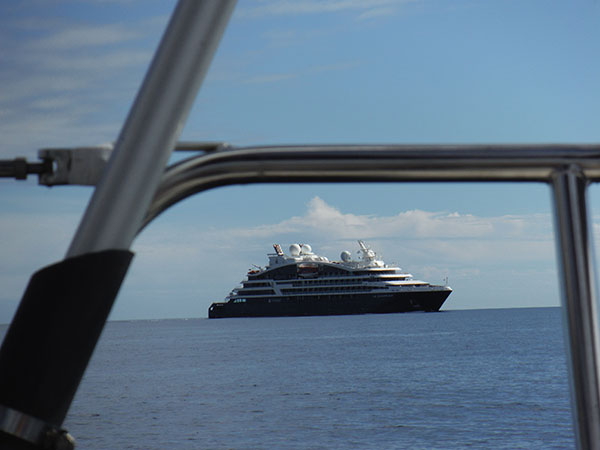
Line up of large boats going in and out of Peterhead Harbour – the boat behind us!
This was fortunate as there was a long lineup of large ships coming into the harbour and each one right behind the other. We contacted the Harbour Master on the Marine radio channel 14, and he gave us a slot to go in. I did not want to push the engine which would only give us 5 knots of boat speed anyway, and wanted to come in no faster than 4 knots. But the large vessel behind us was catching way to fast, so when the Harbour Master asked us to stand off and let the approaching vessel in ahead of us – I was quite relieved. We came into Peterhead Harbour, which is a well-protected deep harbour with a marina at the end of the harbour in a little pocket of its own. We called the Marina Manager on the mobile phone, (boy, things have changed) Keith Bristol was quite friendly and very accommodating, and told us to take any slip just after the entrance. Which made taking a berth very easy indeed. Slept 12 hours!
Peterhead Marina was a delight, with sheltered and well-maintained floating docks. The manager could not have been more welcoming. What a contrast with Port Edgar in which after being there for 18 years The PE manager did not even turn in his seat to wish us well when we were checking out in the office for the last time, and handing in our power meter and fob. So glad I’m not there anymore!
We had intended in only staying 1 night in Peterhead Marina, but the manager asked if we would be attending the annual BBQ the next day? (Saturday – free BBQ and free drinks for the berth holders and visitors!) This place just kept getting better and better! The weather forecast was still good for the next day after the BBQ – Sunday, so it was a no brainer.
We met Andy and Candy (pb Drakkar) who had a berth at Port Edgar and were heading in that direction from Scotland’s West Coast. They had endured a rough passage out from Inverness to Peterhead and had sustained some damage to their 32-foot Criss Craft. There was some rough seas and the constant pounding into the waves took its toll.
We had a good sleep and explored the town the next day and picked up a few treats at the local Aldi store. The BBQ put on by the marina was just right for the size of the marina. There was plenty of food on offer, burgers, hot dogs, chicken … and free beer and wine as far as I could see. They do this BBQ every year at the end of the season, and we just happened to be there – right time right place!
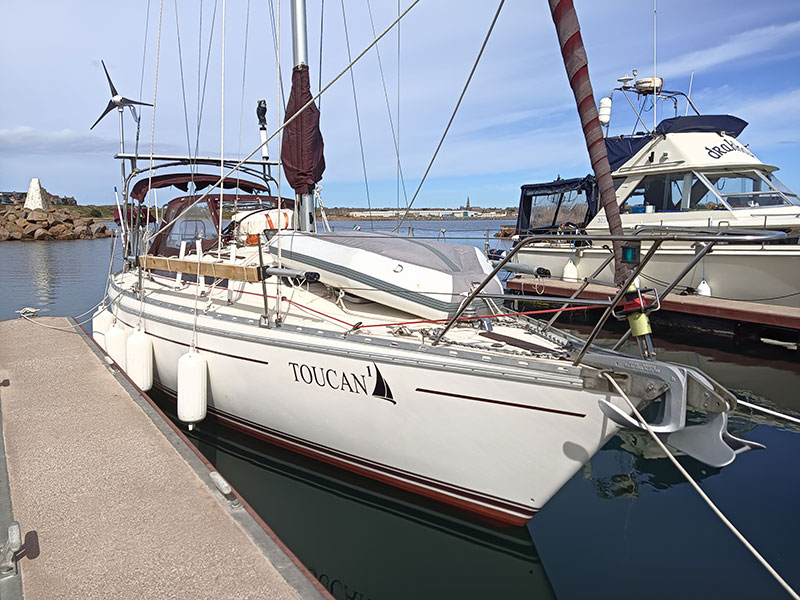
Toucan docked in Peterhead Marina
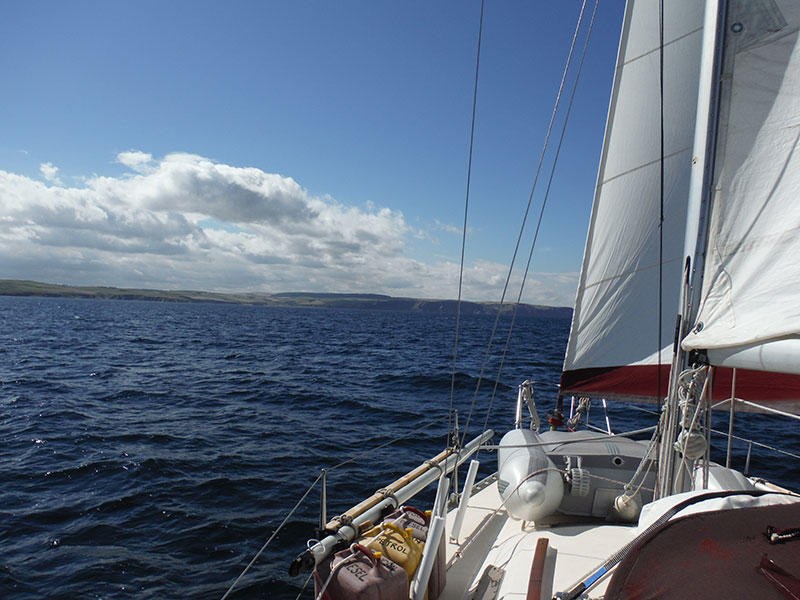
Toucan sailing along the Moray Firth coastline
We were up early the next morning 5:00 am and after contacting the harbour control at 7:00 am we motored out of the large commercial harbour and out to fairly flat seas. Since it is the corner of Scotland that sticks out quite a bit, we went out to sea about 5 miles before turning the corner to avoid any strong currents. 9:00 am, 2 kts of wind, 1.8 kts of current going around the headland at Rattray Point. By the time we got out that far a nice breeze that had picked up. The weather was supposed to be 10 to 15 knots from the North East. Course change for Kinnaird Head 310 Deg. Motor sailing. Had to take in the Genoa, and motor sail with the main sail. Seals, Dolphins and a Minke whale sighted. We saw some dolphins leaping out of the water about a mile away, but it was behind us so no point in approaching them. It was a lovely morning and early afternoon sail, watching the land slip by.
By late afternoon the wind picked up quite a bit and we were looking at 20 to 25 kts which by itself is not a problem but the tide had now changed and it was 25 kts of wind against a strong current, and the waves built up accordingly 6 foot plus. Since it was now very rough, we decided it was safer to take down the mainsail while there was some daylight available and use the Genoa roller furling for the night. This proved to be a wise choice. We could not enter any of the small harbours along the North coast as almost all of them were too shallow depending on the tide, and being unknown to us were just asking for something to go wrong in the dark. The only thing left to do was to kill time and endure the rough seas as best we could. We did not want to arrive in Inverness in the dark as is it quite complex navigation for a few miles on the approach.
It was very cold that night, but eventually the seas calmed down by 5 am, I suspect this happened when the tidal current went somewhat in the same direction as the wind. At one point we only had a handkerchief of a Genoa up and we were doing 2 to 3 knots to the good (cog).
By morning light, we were navigating from buoy to buoy in the ever-narrowing channel on the approach to Inverness. Flat seas and no wind – go figure! We were keeping the green buoys to our starboard, and red buoys to our port, the opposite of the North America buoyage system. We originally had set up digital mapping on our tablet that would show our progression as the tablet had GPS built in. A far cry from the 1990s when our first GPS only displayed latitude and longitudes and had to be transferred onto our paper charts in regular intervals. But the tablet started to crash with the nautical chart program, so we were down to using the charts with my phone. Which was okay but a bit small. We of course had all the large-scale paper charts for all of Scotland and Ireland, and a few small-scale charts of all the UK, with all the pilots guides for the whole of the UK.
In passing Fort George on the South shore, it was interesting to see all the people lining the North shore at Chanonry Point first thing in the morning. Apparently, there is a chance of seeing dolphins performing in the small narrows between the North and South shores as I assume that the fish are funnelled through this gap when the tide changes. And if fish are concentrated in a small gap, you will find dolphins seeking an easy meal, and perhaps a whale or two.

All the people lined up along Chanonry Point early in the morning for a chance to see a dolphin display
After the narrows we entered a very calm sea loch the Moray Firth, and had a pleasant leisurely hour of motoring along past forests of Scotch pine towards Inverness bridge. The loch is quite shallow and you have to navigate it by skirting along very close to the shoreline. But it is well marked with buoys all the way and navigation is quite easy. The current was in our direction and we made quite good progress. Again, Kessock bridge is at a narrow gap in the loch and the current is reported to be very strong here. To the point if you wish to go under the bridge against the current it is advised to wait until slack tide or the current is with you. After going under the bridge there is a sharp 90 degree turn to port to enter the channel for the marina, and the channel is marked with a large buoy. It was all I could do to not collide with the buoy as the very strong current was going in the direction of the buoy! Once past the buoy and into the channel in the river Ness past the Beauly Firth there is another 90 degrees turn to port to go into the very small entrance to the marina. Once in the current is negated and we quickly found a berth. Toucan was now safely tied up! Again we slept 10 hours!
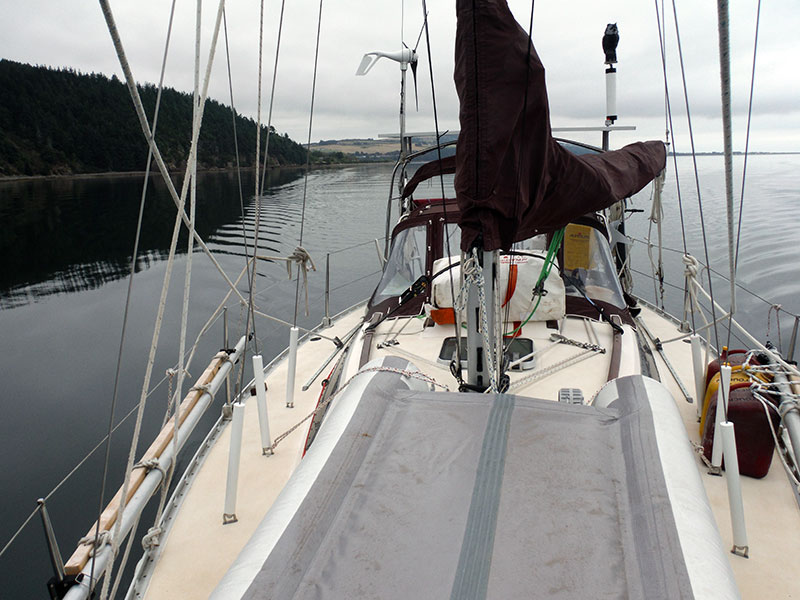
Toucan motoring along the Moray Firth near Inverness
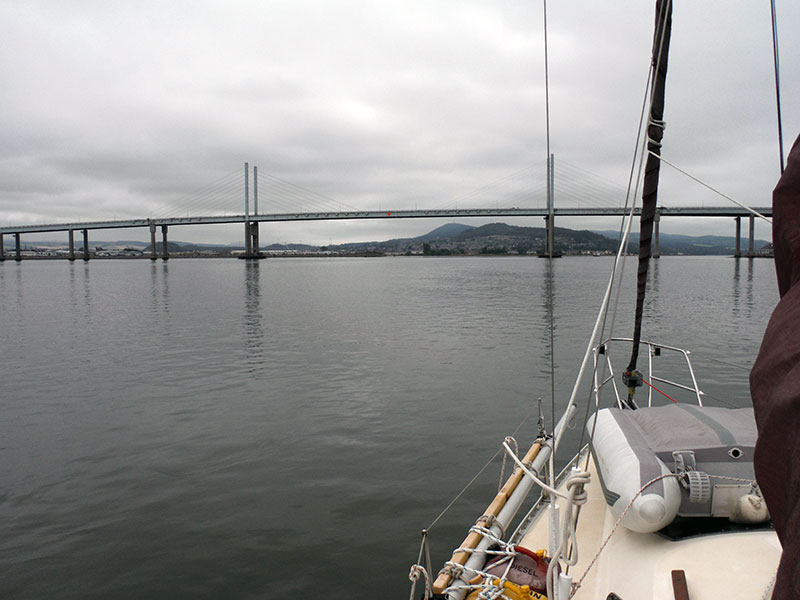
Toucan approaching Kessock bridge, Inverness
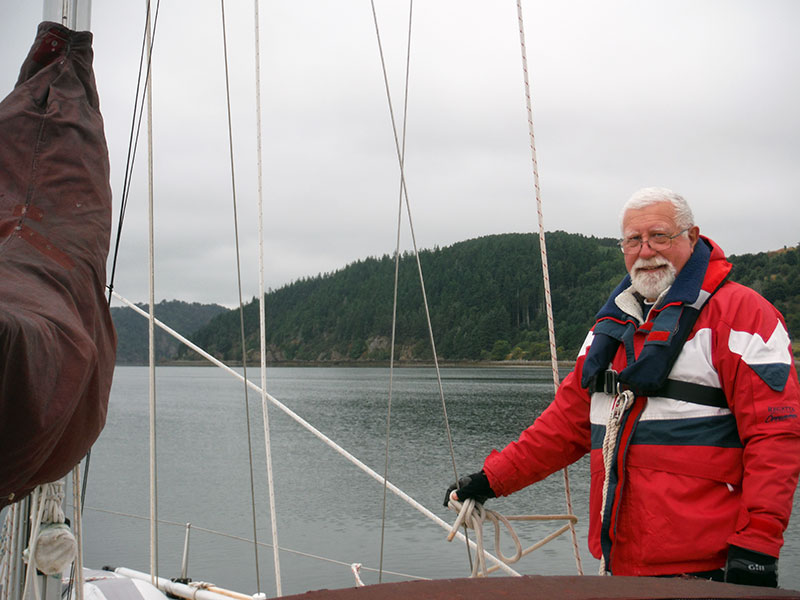
Willie on deck
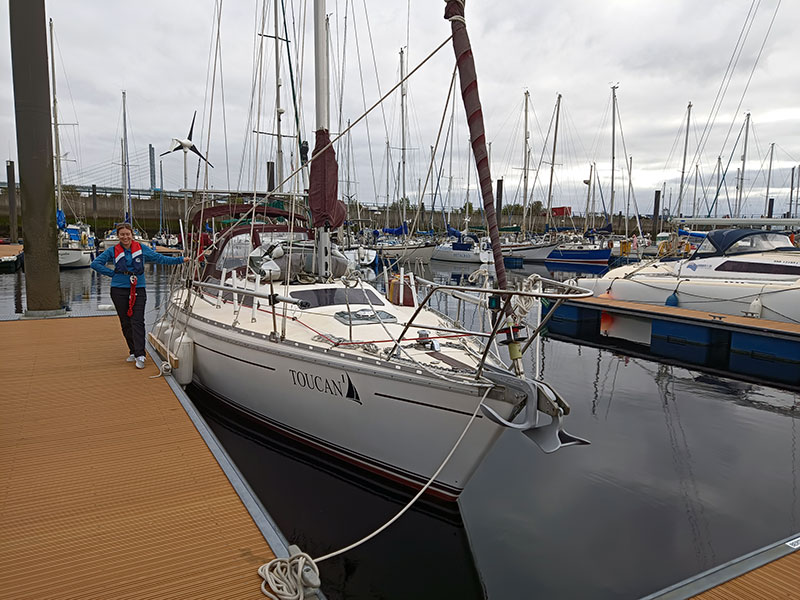
Toucan safely docked in Inverness Marina with our new crew member Heather
We were in Inverness for two days so that we could pick-up a new crew member – Heather (a client of long standing) who would accompany us through the 29 locks in the Caledonian Canal in the Great Glen that cuts through the middle of Scotland from South-West to North-East. The great Glen is made up of two small lochs and a large one that is well known – Loch Ness of the Loch Ness Monster fame. Having an extra crew member along while transiting the 29 locks is a great idea. While one walks the bow dock line the other crew member walks the aft dock line and together both walk the sailboat along from one lock to the next lock. That left the steering and engine control for me to do. Perfect combination. Going through the locks was a bit hairy at first, but after a few of them we had all the lines sorted and it became somewhat routine.
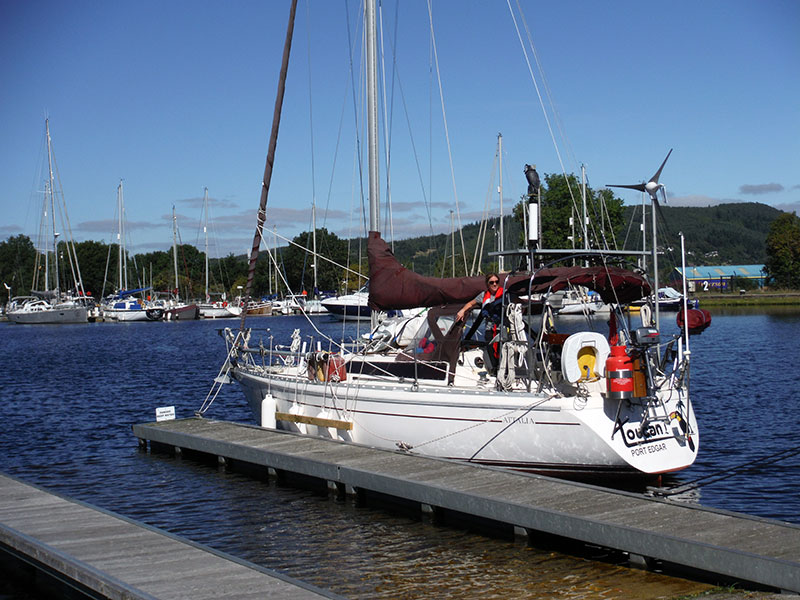
Spin the boat around and do a Captain Ron docking into the wind
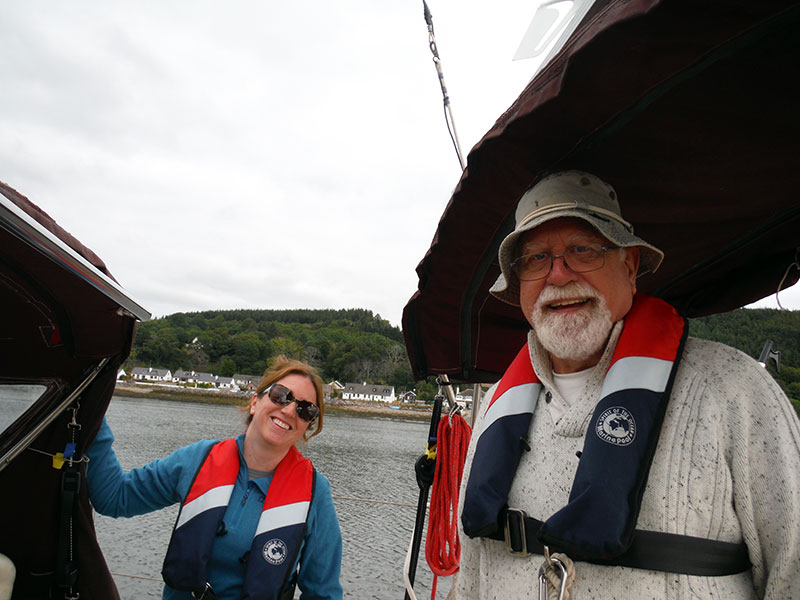
Willie and Heather having a laugh while motoring up the canal
Left Inverness at 10:00am and hung around outside Clachnaharry Lock until instructed to enter the lock. At Cale Marina I performed a “Captain Ron” docking as the wind was coming from behind and there was only 1 space on the small dock besides a brand-new yacht. So, after a quick 180 degree turn, I slid Toucan sideways with the engine in reverse and docked her pointing into the wind. Perfect.
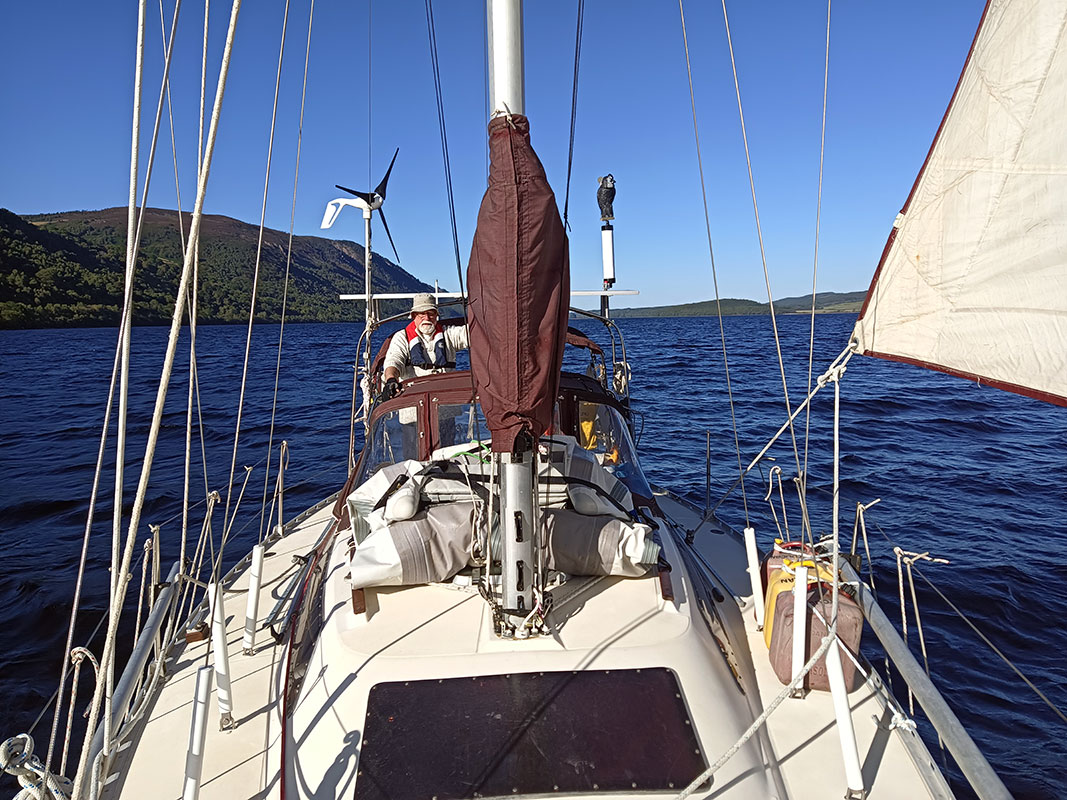
Toucan sailing on Loch Ness. Beautiful sunny day and cruising at hull speed with just the Genoa sail up.
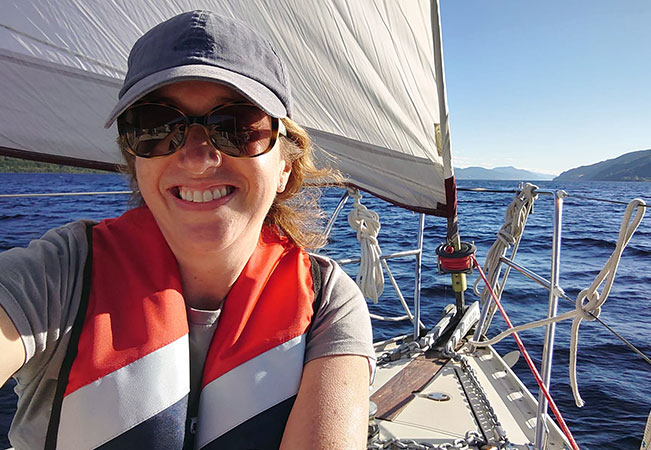
Heather relaxing on deck while sailing Loch Ness
We left the Inverness canal and entered the large and very deep Loch Ness of Nessie fame. We had a great sail for the first one third of Loch Ness as the wind was off our starboard quarter, and it was not long till we were up the loch near Drumnadrochit, and our first overnight stay. Would you believe it, I turned on the engine on the approach to the docks and right away I could hear there was no exhaust water coming out the back. Another air pocket in the sea water pump. We only had a few minutes to dock the boat before the engine overheated, so I just grabbed the first dock that was there. Unfortunately, it was the Deep Scan Loch Ness Research Project Vessel’s dock, and there was a large sign warning vessels to keep off. Withing a few minutes we could see them on the approach but after we shouted our predicament, they berthed in another spot and came over and gave us a hand to move Toucan to the side of the dock. Which to me was too shallow for our 6 foot draught. But as it turned out the bottom dropped off very quickly and we had just enough depth to tie up to the dock. About an hour later I tried the engine again and lo and behold she was pumping sea water out the exhaust.
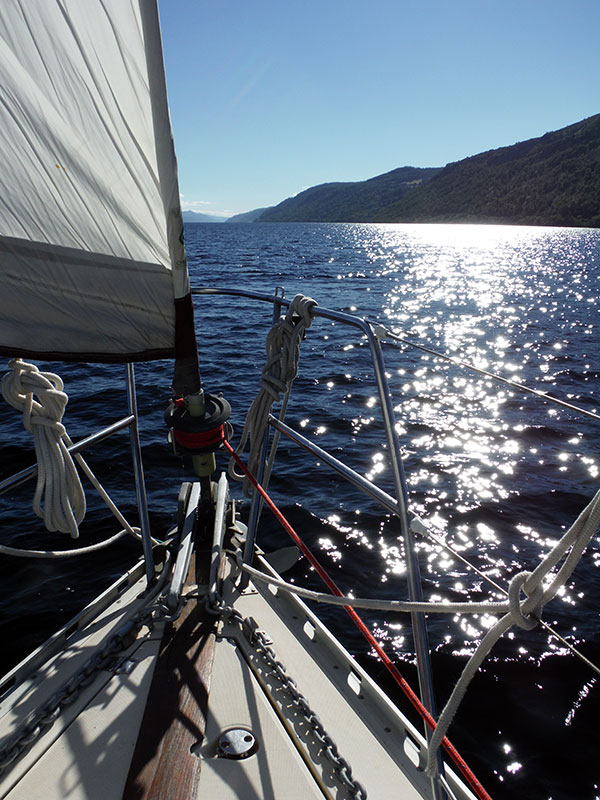
A beautiful day to be sailing on Loch Ness!
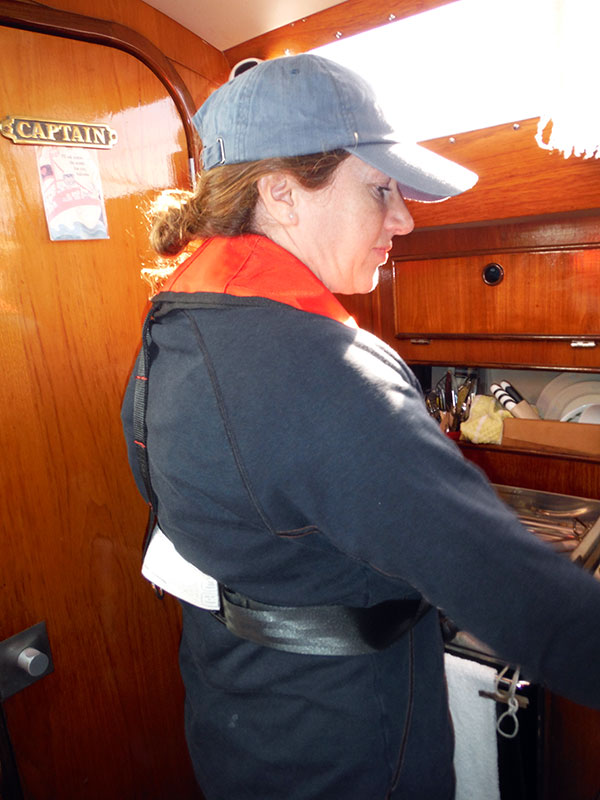
Heather preparing lunch in the galley
The next morning, we were off in the early morning mist, with the pump working fine, and slowly going past Urquhart Castle into the main body of Loch Ness. The mist quickly dissipated, and we found ourselves having to motor directly into the wind. We could have tacked up the narrow loch but it would have taken us way too long to arrive before dark to Fort Augustus. So, a pleasant motoring day up Loch Ness it was.
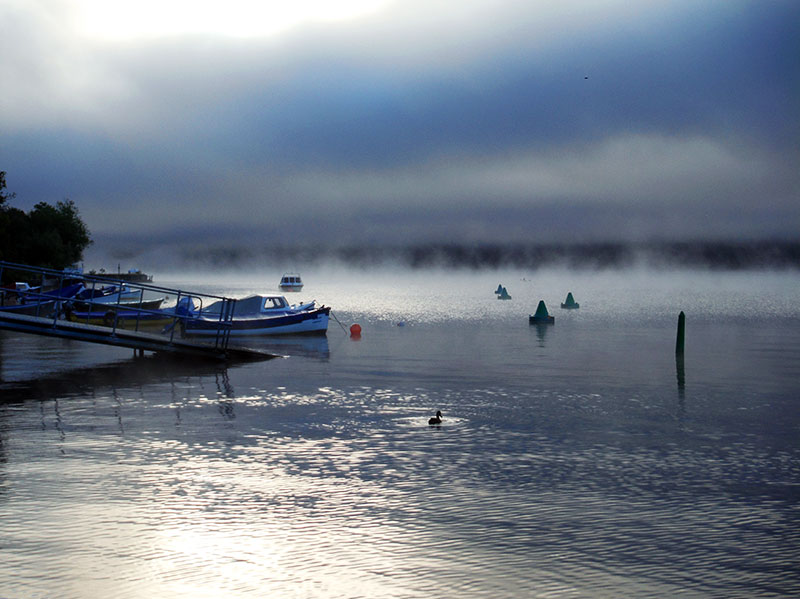
Early morning light on the mist on Loch Ness
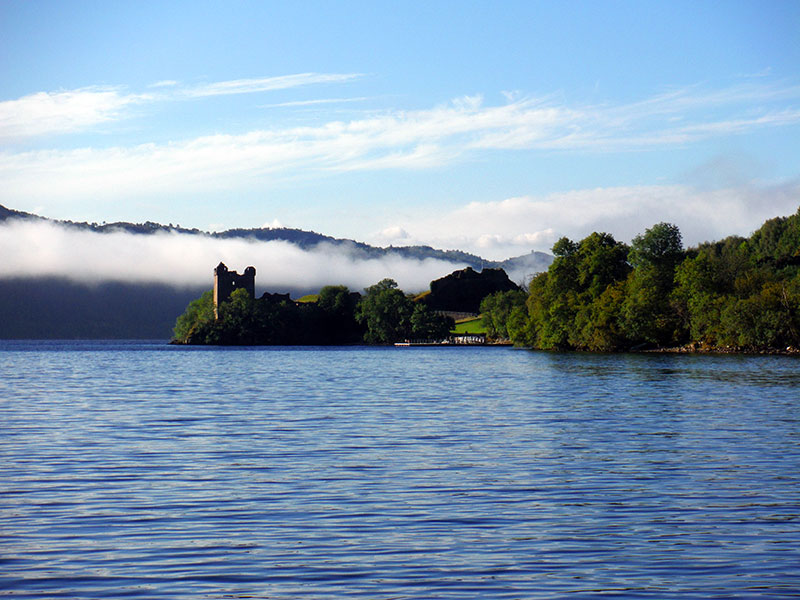
The mist behind Urquhart Castle on Loch Ness
We passed several canoes rafted up together and with improvised sails, and were sailing down wind down the loch! The only other vessels we saw was a large tourist boat motoring towards Fort Augustus, and group of 4 small rental motor boats coming out of Fort Augustus. Mostly it was very quiet except for a very strange wake that was ahead of us and that was proceeding in a Westerly direction across the loch. It reminded me of the famous black and white footage that was taken from the roadside in 8mm film by a tourist. That defied all logic. As there was no vessel nearby to cause such a wake – other than Nessie which must have been slightly under the water because it was not visible in the grainy film – or so it was proposed. Now here we were travelling down the Loch and witnessing the same phenomena with our own eyes! I got Deb to film it with her phone camera, and you can plainly see the wake with no vessel or anything anywhere near it. Strange indeed.
The approach to Fort Augustus was straight forward and the north side was a continuous series of floating docks, and this time of year they were mostly empty. So, we had choice of where to tie up. We choose near to the toilets and showers, but not too near. It was around 2 pm and the lock masters said that they would try and get us up the locks starting at 4 pm. But by 4 pm they were still coming down the locks with a few boats. So, we were looking to stay the night. We decided to explore the small town of Fort Augustus as it is very touristy.
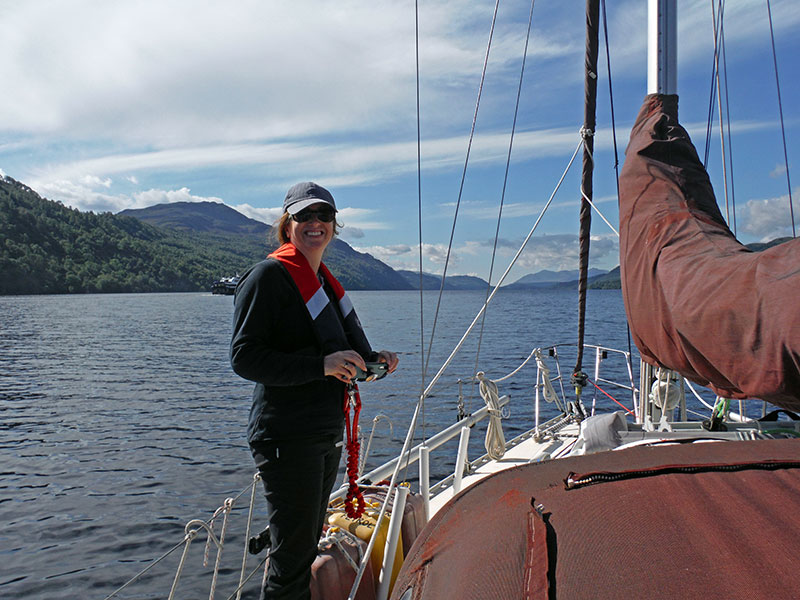
Heather on the foredeck while Toucan motors down Loch Ness
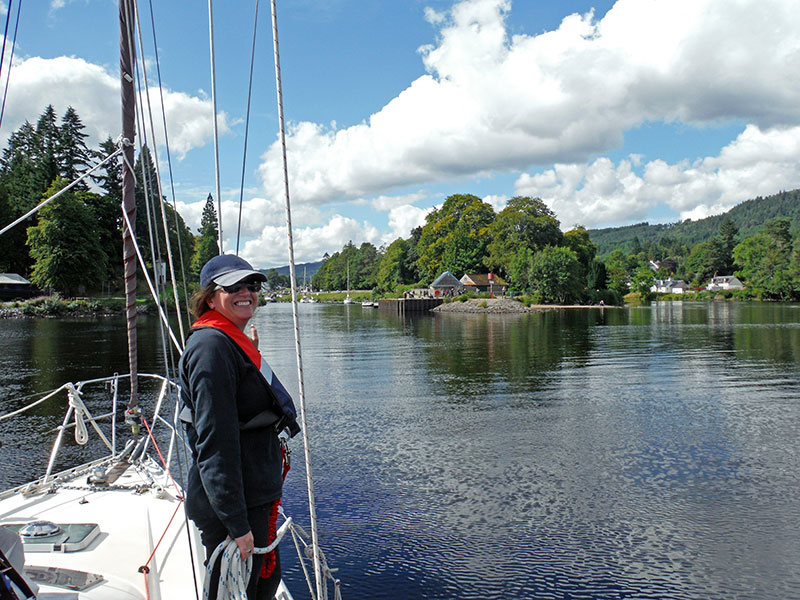
On the approach to Fort Augustus, Heather getting the docking lines ready
We had a treat – excellent fish and chips in town by the locks from the Canalside Takeaway. Very tasty! After the late lunch we explored a monastery and a book stall that was run by the honor system, you donate what you think the second hand book is worth. The lockmasters got word to us that we would be among the first boats going up in the locks the following morning at 9am. We then called it a day and headed back to the showers and then back to the boat to read our newly acquired books and then off to bed.
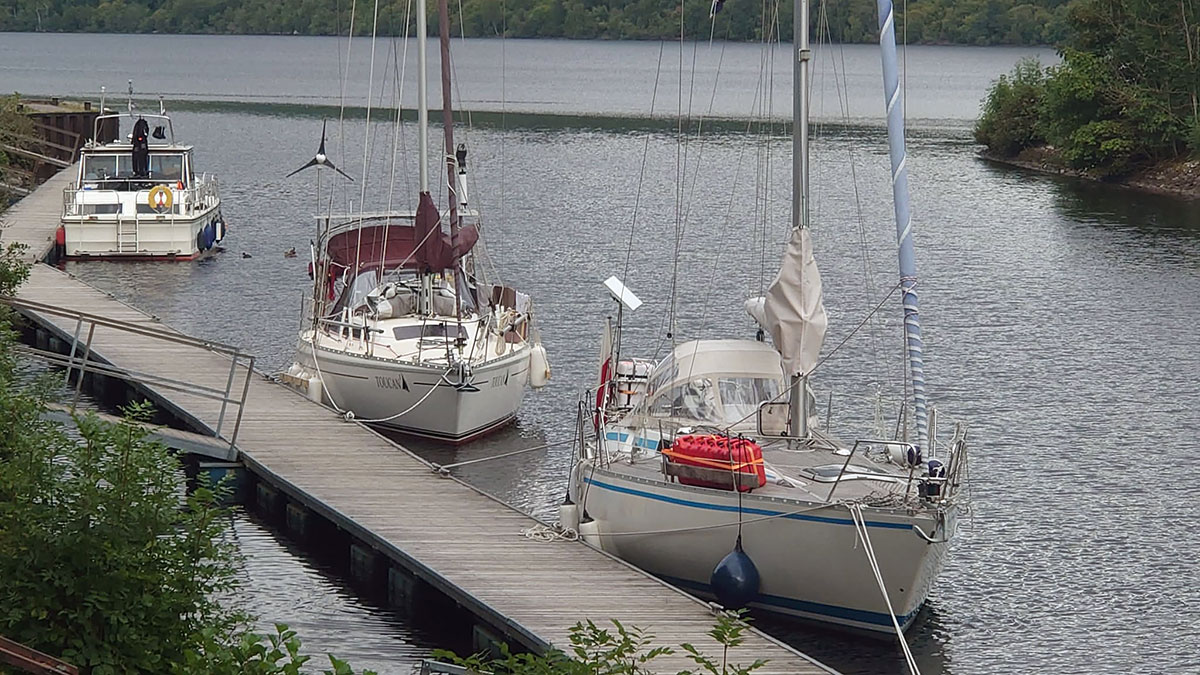
Toucan Docked at Fort Augustus for the night
The next morning, we tried several times to radio the lock masters on the official channel but got no response. So, Heather volunteered to make the long trek to the office to find out what was going on. She reported that when she got to the office, they were all sitting around with their feet up on their desks, and asking Heather why we had not called them on the radio, DUH!. Overall, the lockmasters were excellent in their assistance while we were going through the locks. We had the correct number of crew so did not need hardly any help. A little bit of instruction at the beginning was all we needed. Across from us was the Swedish registered purchased in Poland, sailboat “Se gla ut” who was single handing his way through the canal, and the lock master, who a lot of the time was the only one at the lock. Would always give the single handing captain a hand with the lines.
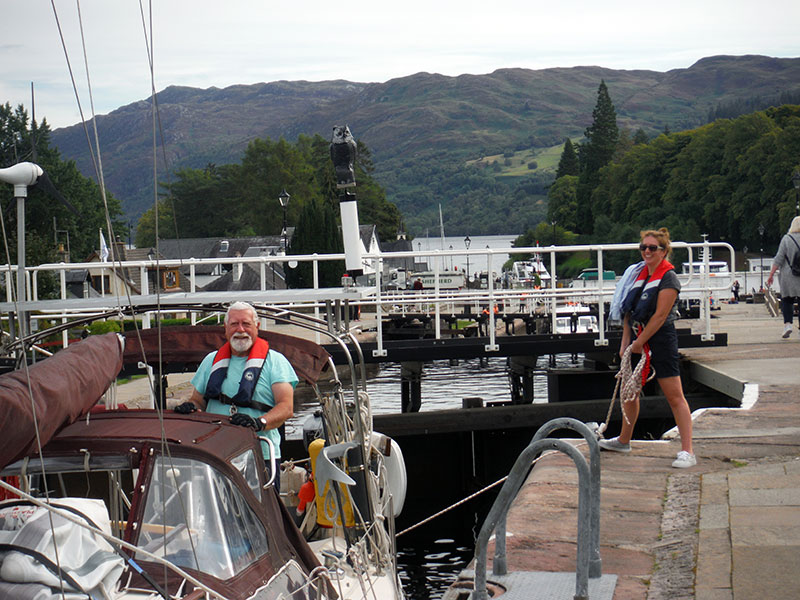
Willie and Heather at Fort Augustus Locks (photo by Deb)
We negotiated the swing bridge and the 6 locks at Fort Augustus and had a long day motoring all the way down the Oich (Caladonian) Canal, the Old Lock Keepers Cottage, the Aberchalder Swing Bridge, through Oich Loch, and the William Arrol Swing Bridge, and through the Laggan Locks out into Creann Loch. The weather was getting rather dark and very windy so a quick turn into LeBoat Docks (very shallow) we managed to get onto the end dock and tie up. This was powerboat rental country, and we were amused watching the new renters go through the half hour practical instruction course, before being giving their boat. For us it was any port in a storm. I got up at 3 am awoken by the screaming wind, to check the lines, and add a few extra ones.
The next day it was an early rise and a quick breakfast before heading off to Loch Lochy, yes Loch Lochy – You would think they could come up with a unique name for this fine stretch of loch! It was still rather windy and it was raining on and off, so the sails were in and out for this loch.
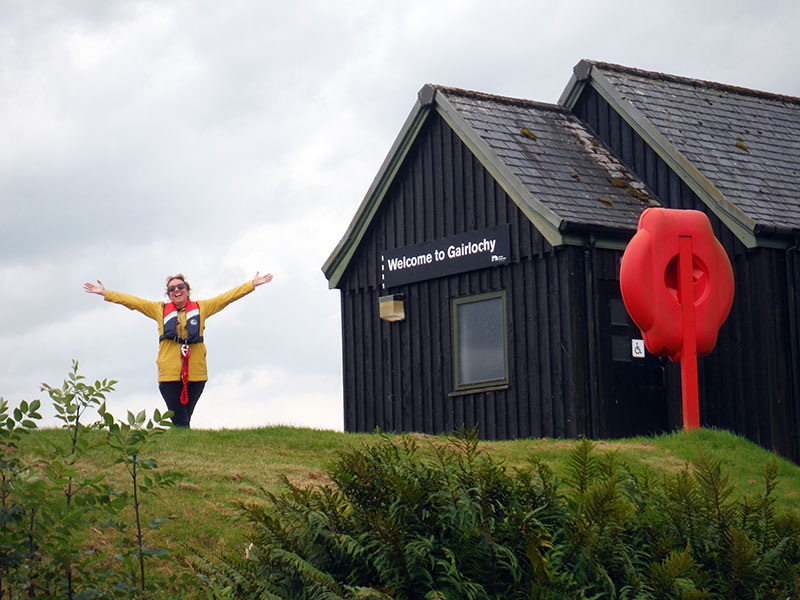
Heather using the shoreside facilities
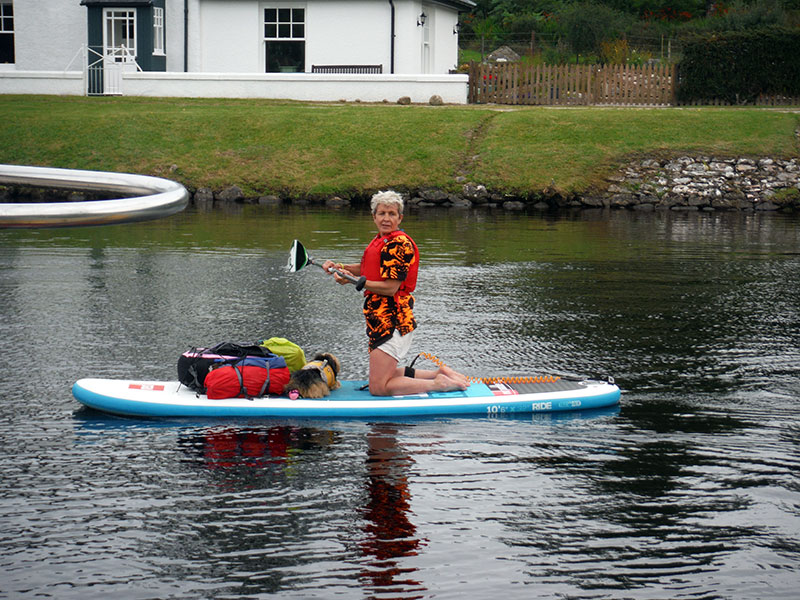
Padleboards were a popular way to transit the caledonian canal
We arrived at Gairlochy locks and the swing bridge. We had a little wait as there was a group of paddle boards coming through from the other direction. It was interesting to see paddleboarders complete with their camping equipment and supplies. And one woman even had her dog on her board. If you are going to paddle board, the canal makes an ideal long calm waterway!
After going through the lock, the lock master radios ahead to the swing bridge to let him know there is a boat approaching. The bridge master is very good at stopping the traffic and timing the opening the swing bridge and contacted us on the radio and instructed us to keep going and to maintain our speed. It was a bit nerve racking heading straight for a bridge and getting quite close and the bridge has not even started to open up yet. But just as I was going to chicken out, the bridge started to open and to my relief quite quickly. Also, the locks just after the bridge were also open and waiting for us. A very long passage along the Caledonian Canal only had one break at the Moy Swing Bridge.
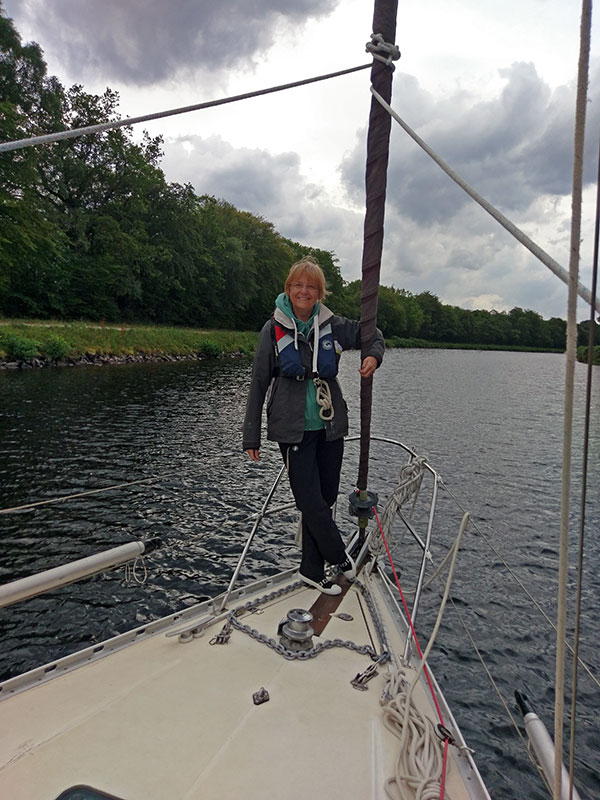
Deb on the bow, the view forward in the canal
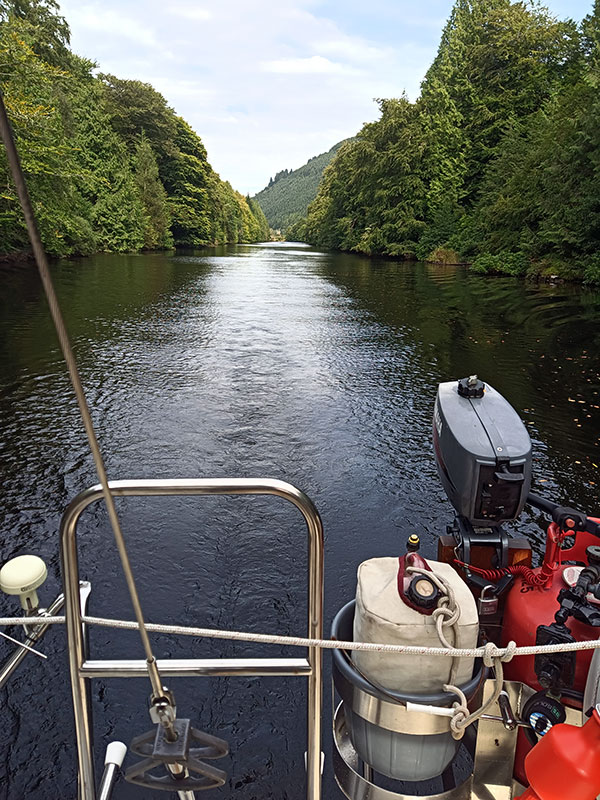
The view aft looking back down the canal – very scenic!
It was then a clear run to Neptune’s Staircase, an 8-lock decent ending in double swing bridges. We tied up to one of the floating shore docks and settled in for the night.
The next morning, we were ready for the 8-lock challenge. Of course it had to be chucking it down, what else. Since the locks are so close to each other Deb and Heather had to walk Toucan along the canal from the canals edge. Not that it was hard enough doing this in the rain, but also having to negotiate past all the tourists that were standing on the canal pathway’s edge trying to take pictures of the canal in action, and could obviously see Toucan being pulled along by very long docklines, but failing to understand that they had to get out of the way!
Finally, we were out of Neptune’s Staircase and past the 2 swing bridges. Another mile or so and we stopped at a dock to let Heather off so she could catch a taxi to the bus station and head back to Inverness. She was due to go to Paris the next day with her sister, and had to get back sharpish.
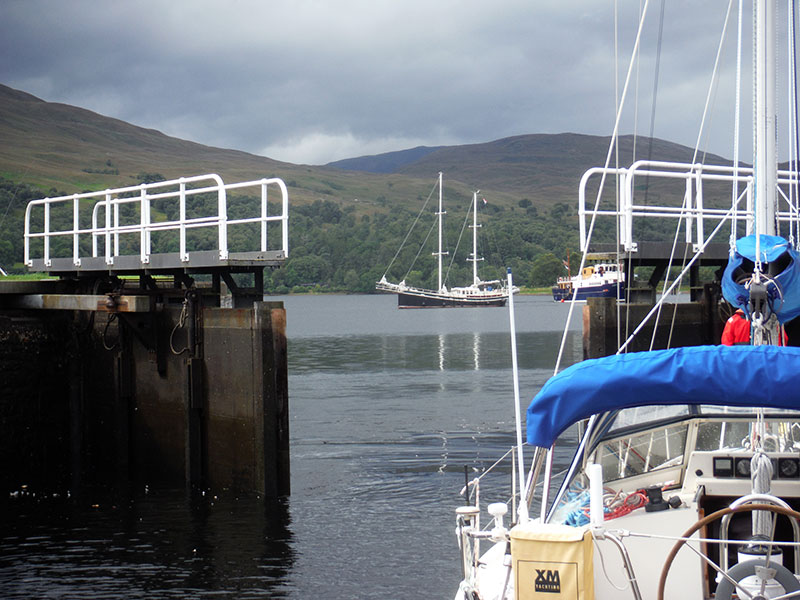
Our First view of Loch Linnhe through the last lock
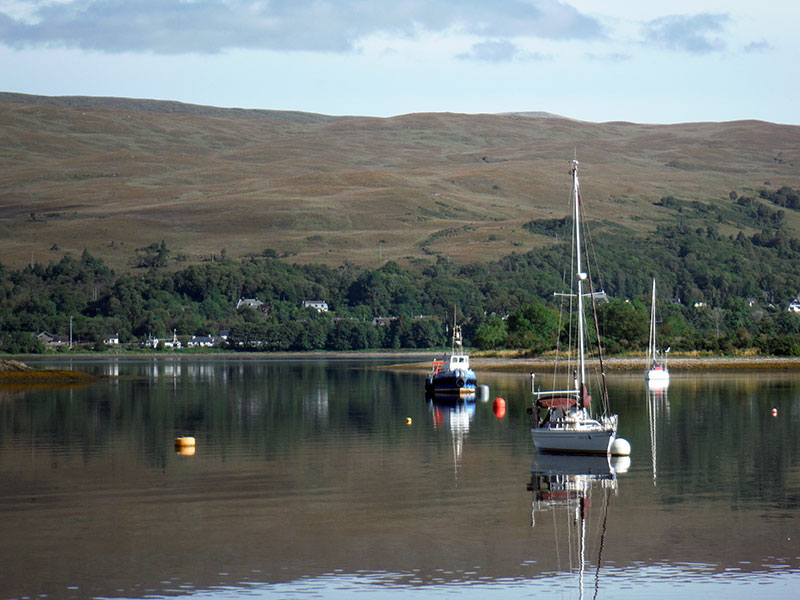
Our new home in the Highlands!
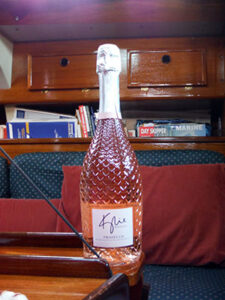
Champers to celebrate!
That left us 2 more locks a small distance to the final lock at Corpach (sounds Klingonese) which leads to the salt water loch – Loch Linnhe. About 1 nautical mile from our mooring in Camusnagaul. The bay across from Fort William. We had to wait a little while, while the tide was at the right level before the lockmaster opened the final gates, and let us go into Loch Linnhe. One mile later we were picking up the mooring buoy at Camusnagaul, and we were home!
We broke out the champaign and had a little celebration, while viewing our surroundings at the foot of Ben Nevis. The tallest mountain in the UK. While we were there, we saw a worker in a large dinghy checking out a commercial fishing boat, and then come over to us after a friendly wave. Fergie McLean introduced himself to us as the unofficial Harbour Master of Camusnagaul Bay. His relatives have been living there since the 1900’s and the rock at the entrance of the bay has a large buoy which bears his name, Mclean’s Rock.
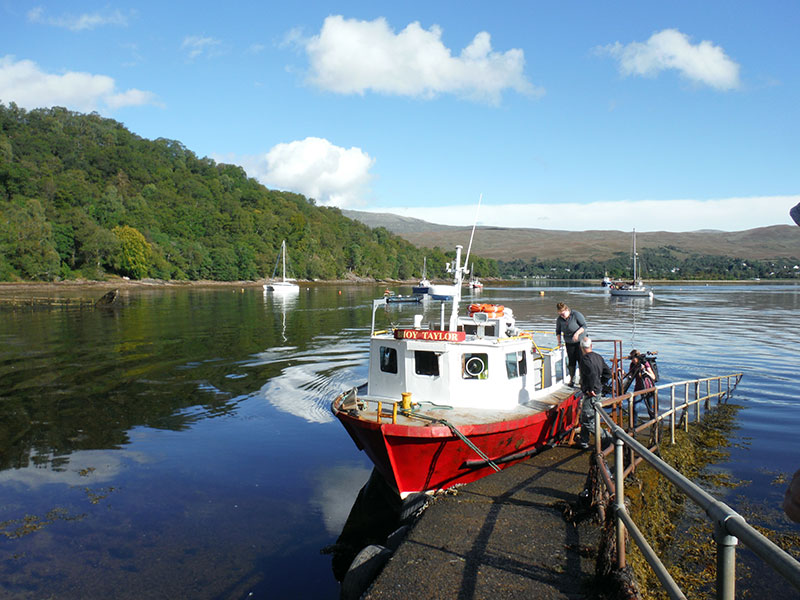
Dougie and Rosie from the Foot Ferry from Fort William (Toucan in the background)
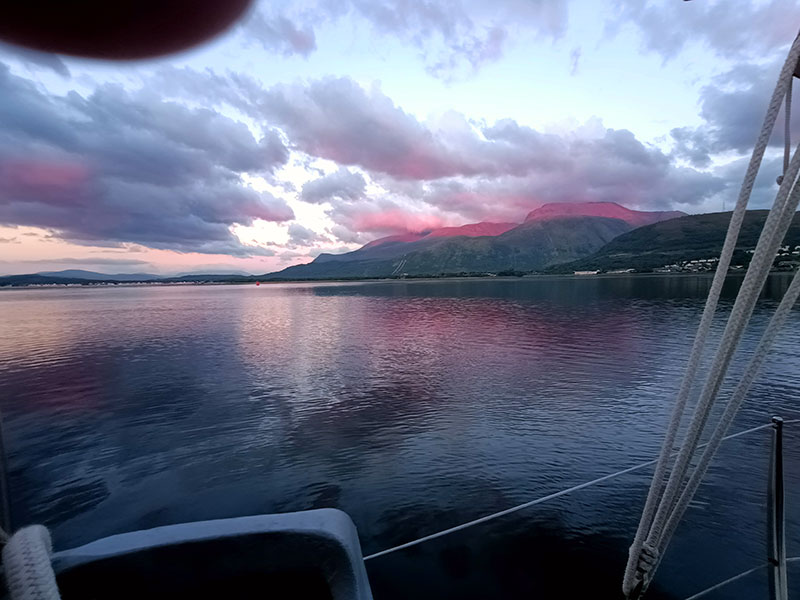
The Sun sets on Ben Nevis – Wonderful!
A little later on while we were settling in, we got a call from Fergie to let us know that there was a pod of dolphins going past the boat, what a location! We were also treated to an unusual sunset, as we are in a valley between 2 mountains and the sun goes down behind the mountain to the West of us rather early. And lit up Ben Nevis with warm glows as it is to the East and considerably higher. I thought a warm welcome to our new home!
